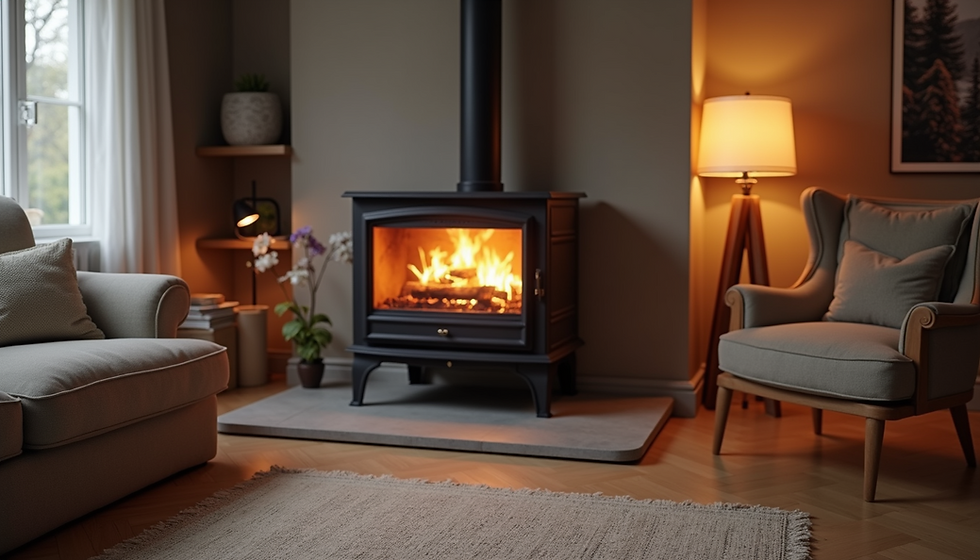Professional Wood Burner Installation Explained
- Alex Moules
- Oct 22
- 4 min read
If you’re thinking about adding a wood burner to your home, you’re in for a treat. A wood burner not only brings a cosy warmth but also adds a charming focal point to your living space. However, installing one is more than just placing a stove in the corner and lighting a fire. It’s a careful process that ensures safety, efficiency, and long-lasting comfort. I’m here to walk you through the wood burner fitting process, sharing what you can expect and how to prepare for it.

Understanding the Wood Burner Fitting Process
The wood burner fitting process involves several important steps, each designed to make sure your new stove works perfectly and safely. First, a professional will assess your home to determine the best location for the burner. This includes checking the floor’s strength, nearby walls, and the route for the chimney or flue.
Next comes the installation of the flue system. This is crucial because it vents smoke and gases safely outside. The flue must meet strict building regulations, so it’s not something to DIY. Once the flue is in place, the wood burner itself is fitted, connected, and tested.
Throughout the process, the installer will ensure everything complies with safety standards and local regulations. This careful approach means you can enjoy your wood burner without worry.
Here’s a quick overview of the steps:
Site survey and planning
Flue installation or inspection
Floor and wall protection setup
Wood burner fitting and connection
Safety checks and commissioning
Each step is important, and a professional installer will guide you through them with care and expertise.
Why Professional Installation Matters
You might wonder why you can’t just buy a wood burner and install it yourself. The truth is, wood burner installation is a specialised job. It requires knowledge of building regulations, fire safety, and chimney standards. A poorly installed stove can cause smoke problems, reduce efficiency, or even create fire hazards.
By choosing a professional, you get peace of mind. They’ll make sure your stove is installed correctly, safely, and in a way that maximises heat output. Plus, many manufacturers require professional installation to keep your warranty valid.
If you live in West Norfolk, working with a local expert means they understand the specific building codes and conditions in your area. This local knowledge is invaluable for a smooth, hassle-free installation.

Do I Need Permission to Install a Log Burner?
This is a common question, and the answer depends on your property and local rules. In many cases, installing a wood burner is considered permitted development, meaning you don’t need formal planning permission. However, there are exceptions.
If your home is a listed building, in a conservation area, or a flat, you may need permission. Also, if the installation involves significant changes to your chimney or external walls, planning permission might be required.
It’s always best to check with your local council before starting. A professional installer can also advise you on this and help with any paperwork.
Remember, even if planning permission isn’t needed, your installation must comply with building regulations. This ensures the work is safe and meets legal standards.
Preparing Your Home for Installation
Before the installer arrives, there are a few things you can do to make the process smoother. Clear the area where the wood burner will go, removing furniture and decorations. This gives the installer plenty of space to work and protects your belongings.
If you have pets or children, consider keeping them away during the installation for safety reasons. Also, make sure there’s easy access to the room and chimney.
You might want to discuss with your installer about the type of wood burner that suits your home best. There are various styles and sizes, so choosing one that fits your space and heating needs is important.
Finally, ask about any maintenance tips or safety advice you should follow once your wood burner is installed. A good installer will happily share this information to help you enjoy your new stove for years to come.

Keeping Your Wood Burner Safe and Efficient
Once your wood burner is installed, keeping it safe and efficient is key. Here are some simple tips to help:
Use seasoned wood: Dry, well-seasoned wood burns cleaner and produces more heat. Avoid wet or green wood.
Regular cleaning: Have your chimney swept at least once a year to prevent soot build-up and reduce fire risk.
Check seals and doors: Make sure the stove’s doors and seals are tight to keep smoke inside and heat in.
Install smoke and carbon monoxide alarms: These are essential safety devices in any home with a wood burner.
Follow manufacturer guidelines: Use your stove as recommended to avoid damage and maintain efficiency.
By following these steps, you’ll enjoy a warm, cosy home with a wood burner that works well and stays safe.
Ready to Warm Your Home?
If you’re ready to enjoy the charm and warmth of a wood burner, it’s important to choose the right professionals for the job. For those in West Norfolk, wood burner installation by local experts means you get trusted service, expert advice, and a safe, efficient stove fitted with care.
Remember, a wood burner is an investment in your home’s comfort and style. Taking the time to get the fitting process right will pay off with years of cosy evenings and happy memories.
Feel free to reach out to discuss your options and start your journey to a warmer home today!




Comments